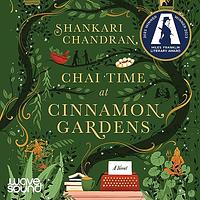You need to sign in or sign up before continuing.
Take a photo of a barcode or cover
Look honestly the book is really a 5/5 for its story, narrative, characters and messaging. BUT the writing style especially at the beginning had me almost DNF. I forced myself to start the book again, and even though my annoyance with the writing wasn’t any less the second time around I’m glad I pushed through because it got a lot better.
It’s a beautifully written, heart wrenching story about racism, immigration and love.
My favourite quotes from the book are:
“Loving was in the detail. Missing was also in the detail.”
“The language was beautiful to look at. Perhaps beautiful to listen to and speak too, but he had never heard it uttered in love”
“Possession of land is nine-tenths of the law. Possession of history is nine-tenths of the future”
“Life is a balance of holding on and letting go. I am letting her go so I can hold onto her and our future grandchildren”
It’s a beautifully written, heart wrenching story about racism, immigration and love.
My favourite quotes from the book are:
“Loving was in the detail. Missing was also in the detail.”
“The language was beautiful to look at. Perhaps beautiful to listen to and speak too, but he had never heard it uttered in love”
“Possession of land is nine-tenths of the law. Possession of history is nine-tenths of the future”
“Life is a balance of holding on and letting go. I am letting her go so I can hold onto her and our future grandchildren”
emotional
reflective
medium-paced
Plot or Character Driven:
Character
Strong character development:
Yes
Loveable characters:
Complicated
Diverse cast of characters:
Yes
Flaws of characters a main focus:
Yes
challenging
emotional
informative
sad
medium-paced
Plot or Character Driven:
A mix
Strong character development:
No
Loveable characters:
No
Diverse cast of characters:
Yes
Flaws of characters a main focus:
Yes
The history in this story and the themes it reflects upon are important. But I found the way it was presented in this novel was clunky and hard to consume. Often there were large monologues from characters repeating the history which felt more like a lecture than a fix story uncovering important events in history. I also felt a lack of connection with a lot of the characters, there were likeable characters in the story but I felt distant from their story. I really wanted to like this book more but the writing fell a bit short for me.
challenging
emotional
informative
sad
tense
medium-paced
Plot or Character Driven:
A mix
Strong character development:
Complicated
Loveable characters:
Yes
Diverse cast of characters:
Yes
Flaws of characters a main focus:
Complicated
challenging
emotional
informative
reflective
relaxing
sad
slow-paced
Plot or Character Driven:
A mix
Strong character development:
No
Loveable characters:
Complicated
Diverse cast of characters:
Yes
Flaws of characters a main focus:
Complicated
A white man? NO
3.5 ⭐️ A dark novel that agitated my sensibilities. Whilst that can be a good thing, I wasn't in the right place to be distressed in such a way. Also, I found the storyline a little bumpy.
Cute title, pretty cover, first few chapters nice and straight forward - you thinking perhaps a straightforward novel of life and living in an old people's nursing home where the residents are of Sri Lankan descent. A mix of Marigold Hotel with Thursday Murder Club characters, with lots of chai tea. Haha - do not be fooled.
This novel won Australia's top literary award last year - the Miles Franklin literary award. Personally I do not think it is a 'novel of the highest literary merit', but it certainly takes a long and hard look at presenting 'Australian life in any of its phases'. The official Australian 'whites only' policy ran from 1901 to 1975. On reading this book, you would think it still persists to this very day. I don't think it compares in its quality of writing to the likes of previous winners such as Tim Winton, Ruth Park, Peter Carey or Anna Funder, but in terms of its subject matter and how that is told it is very good. This is why I have given the novel a 4* rating rather than 3*.
In this case the subject matter is the position of South Asian immigrants and refugees, the lives they make in Australia and the families they raise and the communities they belong to. But this is not enough for the white Australian society they have entered. It is brutal. In fact so brutal, that as the story gathers pace, it seems that this white supremacy/far right political positioning, the social media frenzy that results becomes the story, the plot almost takes a back seat to the agenda being presented.
It is the Sri Lankan Tamil community, the vast majority who came to Australia as refugees and escapees from the truly horrific war taking place in Sri Lanka from 1983 to 2009. Googling this war will give you plenty of background to the novel, as will reading the author's notes at the end. So much of our focus with war in living memory is on WWII and what the Nazis did to Jews, those working for the Resistance, Parstisans, gypsies, dissidents etc etc that it seems the rest of the world and those from other cultures living in our midst are sort of forgotten about or glossed over. So it is with the Tamils from Sri Lanka. Naturally they form their own communities in their new countries - the Cinnamon Gardens nursing home being that place for the elderly residents, the owners, and many of the staff. But it would seem many white people are not happy with such groups living in their midst, feeling threatened by this concentration of a people different from themselves living closely together. It doesn't take much to inflame a situation out of control.
What is so interesting in this novel, aside from learning about the Sri Lanka war and its horrors, is how close to the surface these simmering resentments against minority groups lie, and how wildly it goes wrong. As we know from the pandemic, social media and its disinformation, its manipulation of the truth, is the perfect vehicle to create a tidal wave of movement.
So it is this that becomes the focus of the novel, at the expense of the characters. There are a lot of characters in this story, but aside from the owners of the home, and one of the Sri Lankan staff, we don't learn a great deal of background about the other characters who are crucial to the story. In addition to racism, a civil war, #whitelivesmatter, the plot also deals with the mysterious death of a child, domestic violence, playground bullying, a chemistry lesson, all detracting I feel from the crux of the story being told.
Regardless however, this novel lifts the lid on what is taking place in many countries around the world at the moment as governments deal with the flood of desperate economic, political and religious refugees, migrants seeking work visas for a better quality of life, and increasingly climate refugees. None of this is ever going to go away, this novel being a lesson in how not to do things.
This novel won Australia's top literary award last year - the Miles Franklin literary award. Personally I do not think it is a 'novel of the highest literary merit', but it certainly takes a long and hard look at presenting 'Australian life in any of its phases'. The official Australian 'whites only' policy ran from 1901 to 1975. On reading this book, you would think it still persists to this very day. I don't think it compares in its quality of writing to the likes of previous winners such as Tim Winton, Ruth Park, Peter Carey or Anna Funder, but in terms of its subject matter and how that is told it is very good. This is why I have given the novel a 4* rating rather than 3*.
In this case the subject matter is the position of South Asian immigrants and refugees, the lives they make in Australia and the families they raise and the communities they belong to. But this is not enough for the white Australian society they have entered. It is brutal. In fact so brutal, that as the story gathers pace, it seems that this white supremacy/far right political positioning, the social media frenzy that results becomes the story, the plot almost takes a back seat to the agenda being presented.
It is the Sri Lankan Tamil community, the vast majority who came to Australia as refugees and escapees from the truly horrific war taking place in Sri Lanka from 1983 to 2009. Googling this war will give you plenty of background to the novel, as will reading the author's notes at the end. So much of our focus with war in living memory is on WWII and what the Nazis did to Jews, those working for the Resistance, Parstisans, gypsies, dissidents etc etc that it seems the rest of the world and those from other cultures living in our midst are sort of forgotten about or glossed over. So it is with the Tamils from Sri Lanka. Naturally they form their own communities in their new countries - the Cinnamon Gardens nursing home being that place for the elderly residents, the owners, and many of the staff. But it would seem many white people are not happy with such groups living in their midst, feeling threatened by this concentration of a people different from themselves living closely together. It doesn't take much to inflame a situation out of control.
What is so interesting in this novel, aside from learning about the Sri Lanka war and its horrors, is how close to the surface these simmering resentments against minority groups lie, and how wildly it goes wrong. As we know from the pandemic, social media and its disinformation, its manipulation of the truth, is the perfect vehicle to create a tidal wave of movement.
So it is this that becomes the focus of the novel, at the expense of the characters. There are a lot of characters in this story, but aside from the owners of the home, and one of the Sri Lankan staff, we don't learn a great deal of background about the other characters who are crucial to the story. In addition to racism, a civil war, #whitelivesmatter, the plot also deals with the mysterious death of a child, domestic violence, playground bullying, a chemistry lesson, all detracting I feel from the crux of the story being told.
Regardless however, this novel lifts the lid on what is taking place in many countries around the world at the moment as governments deal with the flood of desperate economic, political and religious refugees, migrants seeking work visas for a better quality of life, and increasingly climate refugees. None of this is ever going to go away, this novel being a lesson in how not to do things.
If I could give this a 10/5, I would. Powerful stuff. Chandran held my emotions in the palm of her hand.
Edit. (mild spoiler):
Having read some of the comments on 'Chai Time at Cinnamon Gardens' (what the hell was I thinking), I have to add to my review:
If you think Gareth and the characterisation of his problematic behaviour one-dimensional (I disagree) and then go on to replicate his sentiments almost-verbatim in your comments ("racism is bad, but I'm offended as a white person that this book isn’t about people like me," or "your depiction of someone like me [Gareth] is offensive because they're contextualised as problematic") - you are both missing the point of the book and making it, in one fell swoop. The irony would almost be delicious, if it wasn't so fucking sad.
We should be celebrating the chance to deepen our understanding of the experiences of others. If you're offended that you're not centred in this book, pull your bloody socks up.
Edit. (mild spoiler):
Having read some of the comments on 'Chai Time at Cinnamon Gardens' (what the hell was I thinking), I have to add to my review:
If you think Gareth and the characterisation of his problematic behaviour one-dimensional (I disagree) and then go on to replicate his sentiments almost-verbatim in your comments ("racism is bad, but I'm offended as a white person that this book isn’t about people like me," or "your depiction of someone like me [Gareth] is offensive because they're contextualised as problematic") - you are both missing the point of the book and making it, in one fell swoop. The irony would almost be delicious, if it wasn't so fucking sad.
We should be celebrating the chance to deepen our understanding of the experiences of others. If you're offended that you're not centred in this book, pull your bloody socks up.
challenging
informative
sad
fast-paced
Plot or Character Driven:
Plot
Strong character development:
No
Loveable characters:
Yes
Diverse cast of characters:
No
Flaws of characters a main focus:
Yes



